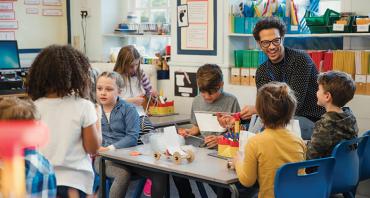As the research in this issue of American Educator makes clear, adverse childhood experiences literally change the brain and negatively impact students’ abilities to learn. This same research also demonstrates the undeniable power we have as educators to help counter the effects.
While we cannot control much in children’s home lives, there is reason for hope. Our students spend a significant amount of time with us in school. From the moment they step foot on school grounds, we have the opportunity to nurture, build up, and even heal our youth who need the most from us.
Even if you don’t teach many students who regularly experience adversity at home, it is important to remember that neglect, abuse, and household dysfunction affect all demographics. Chances are there are students suffering in our classrooms, even if we are unaware of the situation at home.
And while this topic may feel overwhelming, Share My Lesson has you covered. Let’s explore a few of the amazing resources that can help combat the impact of trauma on children’s development.
Provide a Safe, Nurturing Environment
How nurturing is your classroom? Are students encouraged to take risks and learn from mistakes? Is teasing tolerated or immediately addressed as unacceptable? In the blog post “Make Your Classroom a Safe Place for Students,” Share My Lesson contributing author Julia Thompson shares quick tips on making our classrooms safer.
Once we establish safe classrooms, we can take steps to ensure all students’ voices are valued and heard. Check out Amber Chandler’s blog post “Be Seen. Be Heard. Be Known: Mentoring Students to Use Their Voices.” Asking students to contribute in class can counter the effects of neglect. Let’s make sure each child feels he or she is a valued and contributing member of our schools.
We can help students navigate difficult situations with resources from an entire collection dedicated to “Helping Children Cope with Traumatic Events.” One such resource is “Healing Gestures,” demonstrating precise ways to reach out to students and counter the impact of trauma.
Bring on the Joy
There is reason to believe in the old adage that laughter can cure many ailments. How joyful is your classroom? How often do you all let out big belly laughs together? A webinar called “Let’s Have Fun” shows positive ways to build social and emotional learning into literacy lessons.
Another resource, “Building a Joyful Learning Environment,” includes tips and a self-reflection tool to help us consider areas that could be improved, such as using the physical space of our rooms to support learning and positive classroom culture.
Increase Order and Predictability
We can do a lot with routines and structures in our schools to counter the effects of the pain and distress our children may face outside of school. While we want to increase joy, which can include the element of surprise, we also want students to know what to expect from their daily schedules.
For the brain that has experienced trauma, daily rituals and predictable patterns in schedules can be powerful ways to assure and calm heightened nervous systems. Our “Classroom Management and Teaching Strategies” mega collection contains more than 600 lessons and other resources for taking your classroom environment to the next level. Topics include bullying prevention, internet safety, restorative discipline practices, and more! There is also a whole collection of webinars on building a healthy school climate, so be sure to share this with your administrators, paraprofessionals, and other essential support staff at your school.
Finally, explore our partner profiles and pages for more free resources. The American Psychological Association, for example, has shared more than 20 lesson plans and articles that help teachers use the power of science and psychology to improve learning and well-being in schools.
The resources here are excellent for all students, even those unaffected by trauma. All people need connection, safety, play, and predictability to learn well and to thrive. We hope you find tools here that empower you to continue your great work with our children. If you have additional ideas or requests, please reach out to us at content@sharemylesson.com.
–THE SHARE MY LESSON TEAM

